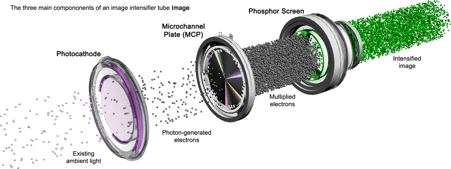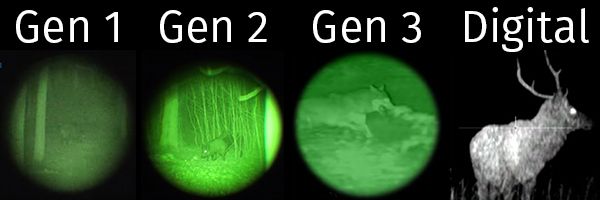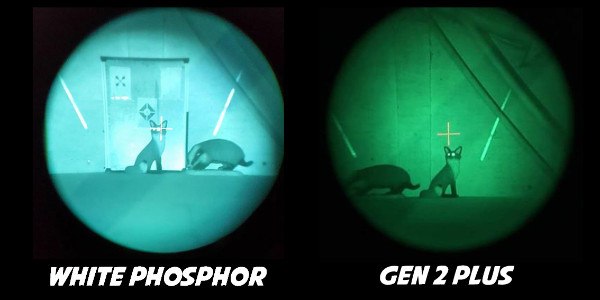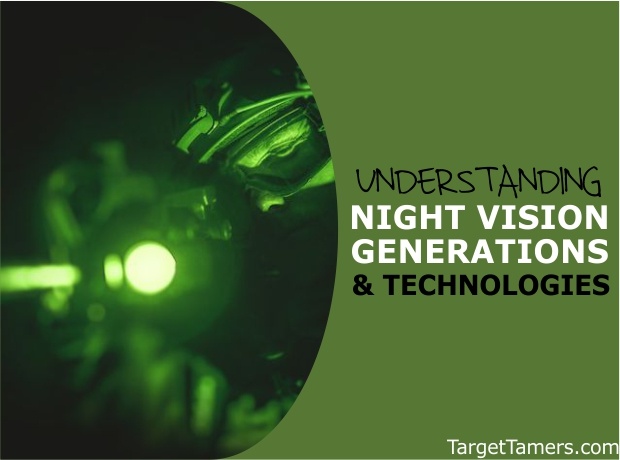
Night vision generations - we're definitely not talking about generational family trees or Star Trek (gotta love it!). It's far more simple than that.
Night vision generation classifications refer to the type of image intensifier tube used for the night vision scope. It's the meat or soul of the entire unit.
It might not be the most interesting thing in the world to learn about since you're itching to get out in the dark tonight. But, "Resistance is futile." You've got to know your stuff to buy the good stuff. (Did you get that? Sneaky Star Trek catchphrase thrown in there.)
Let's get onto the difference in night vision generations. "Beam me up, Scotty!"
What is an Image Intensifier Tube?
The image intensifier (I2) tube (IIT) is a vacuum-sealed tube with various components that make up the night vision capabilities of night vision scopes. A complete night vision I2 tube will contain a photocathode, micro-channel plate, and a phosphor screen.
The generation classification comes in to define what night vision scopes have all or some of these internal tube components. Additionally, various raw materials, glass quality, and coatings can be used to determine overall quality, and ultimately, what generation class a night vision device belongs in.
Night Vision Generations
Generation 1
Also known as Gen 1. It's nothing fancy, but it's better than no night vision at all. Gen 1 scopes are also the most affordable night vision devices since budget is a legit concern - and admittedly, we're practically all on a budget these days, right? But, it's more affordable now than ever because Gen 1 tech was developed in the '60s when cell phones didn't even exist. Get the point?
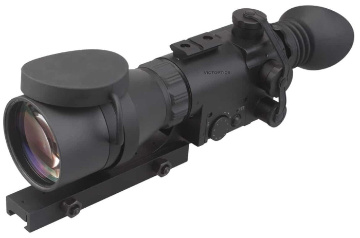
These night vision devices typically lack a microchannel plate, and offer less resolution with more "noise" in the image. Fish-eye lens effects and blooming (excessive light causes image distortion) are inherent of Gen 1 scopes. Shorter lifespan of approx. 1,500 hours. Good for ranges up to about 75 yards. Often requires use of a built-in IR illuminator making you visible to other night-vision users, and it's always activated - no option to turn it off.
If you're one night caught in the dark, fiddlin' and fartin' around with your failing scope, trying as you might to get it to stay on and function, you might find yourself screeching "I'm givin' her all she's got, Captain!" To avoid sounding like Scotty and this unfortunate scenario, you might want to check out what Gen 2 has to offer.
Generation 2
Also known as Gen 2. Contains microchannel plate for accelerated electron gain and image resolution. Provides better than average low light quality and with little distortion. Lifespan of approx. 2,500-5,000 hours. Good for ranges up to about 200 yards. Can operate "passively" without the use of an IR illuminator, but may come with one with the ability of an on/off switch.
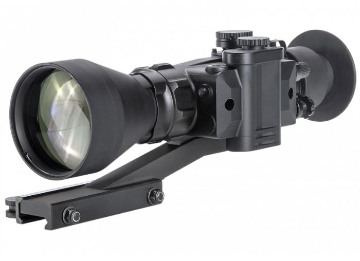
It's a leap up in quality, clarity, and performance versus Gen 1 devices. By how much? It's a lot closer in quality to a Gen 3 device than it is to a Gen 1, however, the price jump will be obvious for the jump up in quality. Within Gen 2, you have various classes. Just like how you can buy a base model sedan for a cheaper price, you can also contemplate a higher-end or fully-loaded model.
Gen 2+, Gen 2ST: The Gen 2+ and Gen 2ST (standard tube) are what you would consider base model gear.
Gen 2CGT, Gen 2MS: Gen 2CGT (custom grade tubes) and Gen 2MS (mil-spec grade) have better performance and quality over base model Gen 2 gear, and they don't typically cost a whole lot more.
Gen 2HPT, Gen 2HP: Gen 2HPT (high performance tubes)/Gen 2HP (high performance) night vision devices are the creme de la creme of Gen 2 gear. Expect a lot more in quality. However, since prices in this high-end Gen 2 range are quite competitive to Gen 3 products, it's almost always the better buy to get the extra battery life of a Gen 3. "Highly illogical," just like how Spock puts it. However, it's true that high-end Gen 2 tech can get very expensive. During product comparison, it may be best to be brand-specific when deciding between a Gen 2 vs Gen 3 when prices are competitively in the same range.
Generation 3
Also known as Gen 3. The most-advanced night vision technology available. Like Gen 2, there are several grades and levels of quality within Gen 3 devices. Contains premium components for multiple benefits such as an ion barrier film to improve tube durability. Can be used in both day and night conditions. Excellent low light performance without the need of an IR illuminator for added covertness. Lifespan of approx. 10,000+ hours. Good for ranges up to about 300 yards and then some (depending on quality).

Gen 3: High quality, long-lasting, and the cheapest of the Gen 3 classes.
Gen 3ST: Gen 3ST (standard tube) are very similar to the basic Gen 3 tubes, however, there can be a little bit of an upgrade in tube quality with less blemishes or "noise" interference in image quality.
Gen 3A: Higher-grade over standard and basic Gen 3 gear. Offers more resolution, clarity, and performance. May or may not come with tube data record sheets.
Gen 3AG, Gen 3P: Gen 3AG (auto-gated) and Gen 3P (pinnacle) devices are the best of the what the Gen 3 industry has to offer for superior performance when artificial light is present. Auto-gating and pinnacle terms offer the same technology, and they're often used either interchangeably, as a product name, or one term is used and preferred over the other.
Generation 4
You're going to see this term a lot, more as a marketing and manufacturer identification term. The classification term was introduced to the U.S. Army, but the technology didn't meet their regulation/performance standards, so it's no longer an official classification as it was redacted.
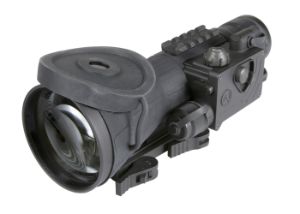
What was that proposed Gen 4 tech? It was the removal of the ion barrier film seen in Gen 3 gear. It was found that by removing the film, the image intensifier tube became too fragile and was without durable integrity. You can just hear the engineers and developers of this tech roar "Khaaan!" (just like Capt. Kirk) as they embarrassingly scrambled back to perfect it. "Make it so" could never be more appropriate than it is right now.
Thanks to modern day advancements in night vision tech, the "filmess" and "unfilmed" tech was perfected! But, it hasn't yet been officially proposed to again be classified as Gen 4 tech.
Other Night Vision Technologies
Unfilmed/Filmless
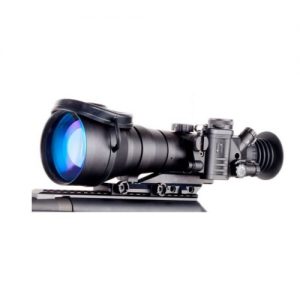
Without an official classification, this type of technology is still termed as high-end Gen 3. Removal of the ion barrier film with the addition of auto-gating technology allows improved image quality like never seen before in night vision devices - like William Shatner says, "To boldly go where no man has gone before", and filmless tech has certainly done that.
Minimal halo or blooming effects from bright light sources, little to no "noise" in image, increased resolution, and a much higher performance rate in low light conditions can be expected from this very expensive tech.
White Phosphor Technology (WPT)
This is the latest night vision tech that allows image quality in black and white, and white phosphor tubes can be compatible with any generation class. However, you'll typically see WPT in upper level Gen 3 devices.
Ceramic Optical Ruggedized Engine (CORE)
First introduced in 2012 by Armasight, it introduces ceramic plates instead of glass ones in Gen 1 tubes. The result is significant optical quality, improved durability, and it remains an affordable device for those on a budget who want better scopes.

Digital Night Vision Devices
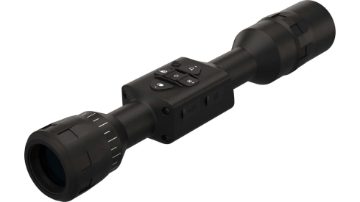
Digital tech is new to night-vision gear. The tube is built differently than a traditional night vision scope as it's been made to be used in any lighting condition. A built-in chip in the digital night vision scope amplifies light detected by the emission of the IR illuminator at night or low light. Since this tech can be offered in various grades of quality, bottom-dollar digital scopes may not be the first option for those who need to be covert in high-stress situations.
However, they're often more price-friendly than true or traditional night vision scopes often competing in price with Gen 1 tech. But, depending on the quality and brand, they could possibly compete with Gen 2 and Gen 3 night vision gear. They often come with the ability to record in real-time. Other digital night vision scopes can offer even more features like rangefinding, ballistic data, and image stabilization to name a few.
Don't Forget Glass!
Unlike thermal scopes that don't depend on light transmission and quality glass to enhance this process, the best night vision goggles and scopes do. Quality glass on a lousy image intensifier tube makes for a lousy scope. Quality image intensifier tubes paired with lousy optics makes for a lousy scope.
As you navigate your way through the night vision generations & different types and qualities of image intensifier tubes, always keep in mind that glass and coatings are just as important. To wrap up, endure one last, famous quote, "Live long and prosper."
Further Reading
- Wire vs Glass Etched Reticles: Which Should You Choose for Your Rifle Scope?
- What Is Your Best Hunting Gear Investment? 25 Expert Hunters Weigh In
- What is the Sight Picture & Sight Alignment? [WITH PICS]
- What Is The Difference Between Reflex Sights VS Red Dot? Find Out Here!
- What Is MOA? Calculating Minutes of Angle & Making Turret Adjustments

